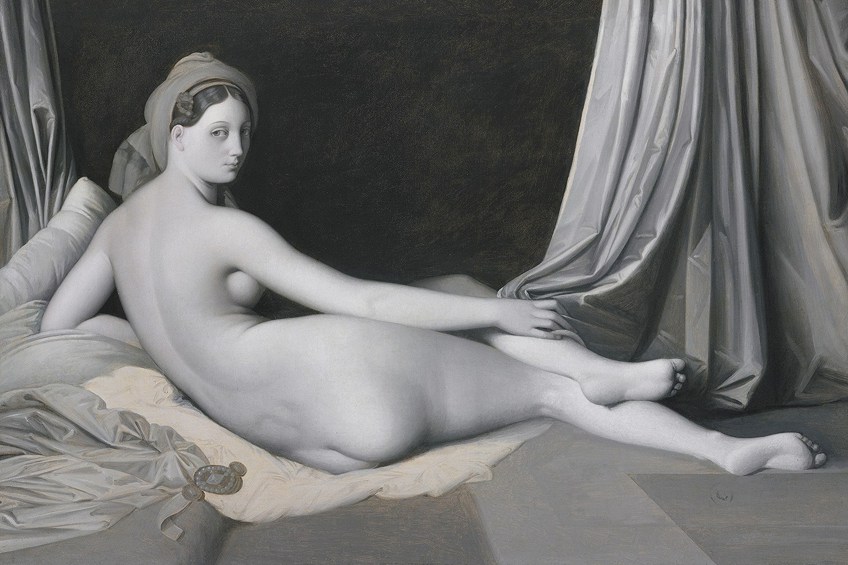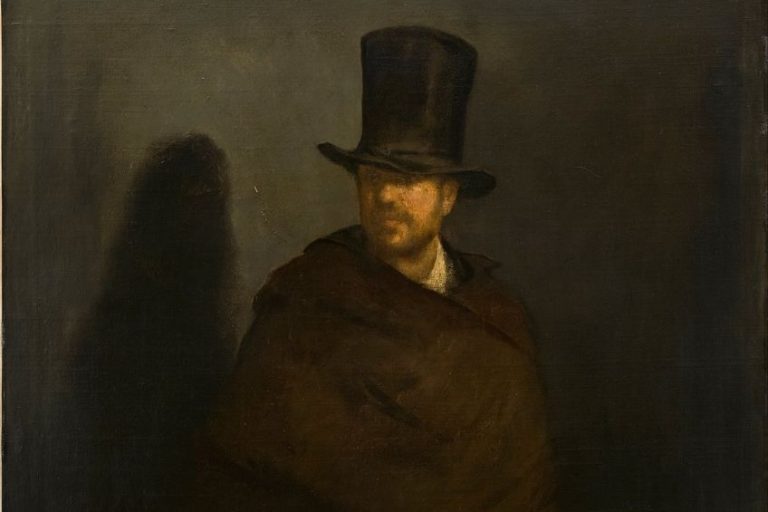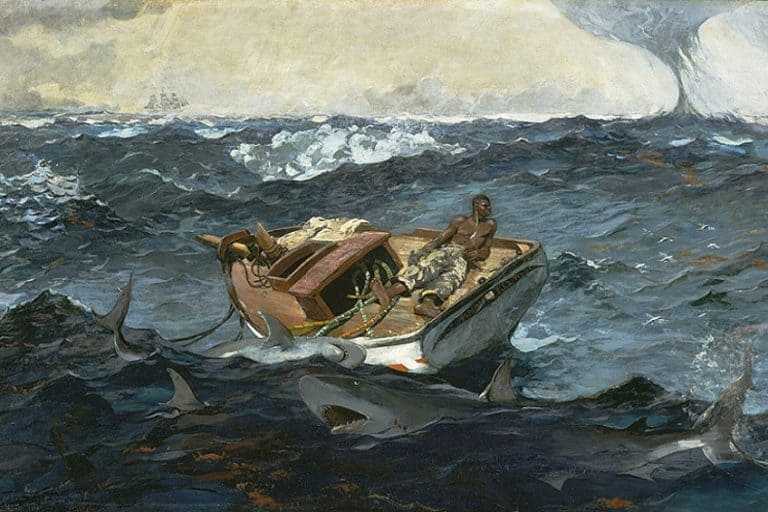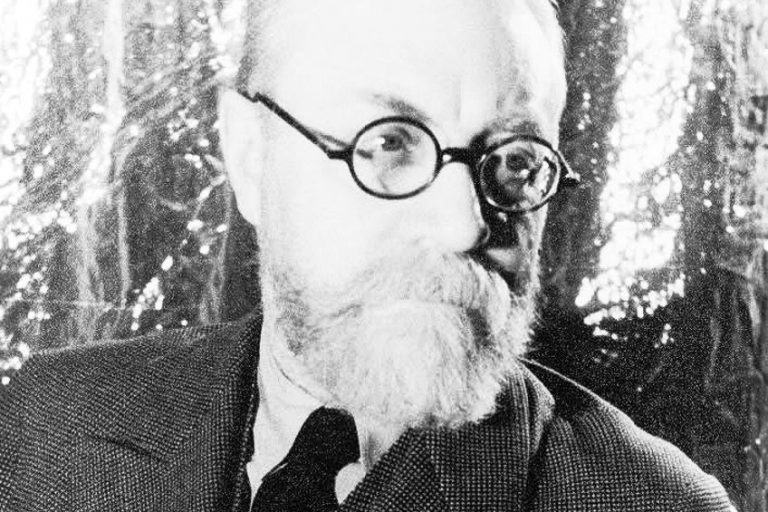Famous Black and White Paintings – 10 Impactful Monochromes
Black and white painters use the absence of color to maximize impact. The stark contrast between black and white has proven effective at emphasizing the contrasting realities and ideals from our world in various artistic depictions throughout history. Many of us are familiar with the sentiment that white symbolizes purity while black signifies something of a darker nature. Well, these artists we have selected as part of our list have taken their own spin on these two distinct shades. Continue reading to find our list of the 10 most famous black and white paintings!
Our List of Famous Black and White Paintings
In the strictest sense, white is the absence of color, but it is also true that black and white exist on the same spectrum. On the neutral gray color spectrum, black and white are found on the extreme opposite ends intimating that restricting a painting’s colors to those of black and white, makes the painting monochromatic. So really, black and white can also exist as one, in harmony rather than always indicating a distinct difference.
Let us explore how these various artists expertly orchestrated magnificent black and white artworks.
Odalisque in Grisaille (c. 1824 – 1834) by Jean-Auguste-Dominique Ingres
| Artist | Jean-Auguste-Dominique Ingres |
| Date Painted | c. 1824 – 1834 |
| Medium | Oil on canvas |
| Dimensions | 83.2 cm x 109.2 cm |
| Where It Is Currently Housed | The Metropolitan Museum of Art, New York, the United States |
Jean-Auguste-Dominique Ingres’ magnificent painting Odalisque in Grisaille is an incomplete repetition of his highly acclaimed Grande Odalisque (1814), the artwork that was fundamental to his abstraction of ideal beauty. Paintings that were executed in shades of gray were usually created as a guide for engravers to identify distinctions in tone for their black and white replicate prints. However, the intention behind Odalisque in Grisaille remains unknown as it was not officially linked to Grande Odalisque.

Ingres’ careful reworking has a simplified composition in comparison to his Grande Odalisque, while also being reduced in scale. Ingres placed the figure in front of a plain black background, which urges the viewer to pay greater attention to the figure itself. The motif of a woman reclining has been popular since the Renaissance. The sinuous lines that Ingres has used to depict the woman highlight the delicate curves of her body.
The rhythmic curve that follows the entirety of the woman’s body demonstrates Ingres’ artistic choices to stylize her figure, as her body is distorted in an illusionary manner.
Ingres maintains a flat plane with his depiction so that her figure remains decorative. Odalisque in Grisaille reveals Ingres’ mastery of his craft as it demonstrates his expertise in the level of his abstraction. The painting exists as a pure image. Ingres’ freedom with the human form urged other artists to experiment and his legacy established him as an instrumental forerunner of modern art.
Black Square (1915) by Kazimir Malevich
| Artist | Kazimir Malevich |
| Date Painted | 1915 |
| Medium | Oil on linen |
| Dimensions | 79.5 cm x 79.5 cm |
| Where It Is Currently Housed | Tretyakov Gallery, Moscow, Russia |
The awe-inspiring painting Black Square by the Russian Avant-Garde artist Kazimir Malevich was the first of four variants. Malevich frequently worked with extraordinarily simple concepts. His famous black and white abstract art is a depiction of a sizeable black square that dominates the linen it is painted on. Over time Malevich’s Black Square has cracked. Malevich first displayed the piece in Petrograd at the 0.10 exhibition in 1915. Black Square is considered by artists, curators, historians, and what Malevich referred to, as the “zero point” of art.

Malevich indicated that his work was part of the Suprematism movement, which focused on the supremacy of artistic feeling. The sole pictorial element in the composition is the square itself, but subtleties such as the visible fingerprints, brushstrokes, and the colors that peek through the cracks beneath the paint, all lend themselves to the magnificence of this painting.
Just the heaviness of the black paint on the white linen gives a sense of visual weight and reinforces the importance of the square itself against the plain background and the feelings it evokes.
Black Square took on seminal importance and is largely considered as one of the most important artistic feats of the 20th century. The seemingly unassuming piece was relatively small, yet when it was exhibited it generated an uproar. Black Square claims to be the first publicly displayed abstract artwork in the Western world. It became the ultimate declaration of reductionism as it removed all figuration, natural imagery, and storytelling; and demonstrated that content is unimportant, that feeling is paramount.
Horse’s Skull with White Rose (1931) by Georgia O’Keeffe
| Artist | Georgia O’Keeffe |
| Date Painted | 1931 |
| Medium | Oil on canvas |
| Dimensions | 76.3 cm x 40.9 cm |
| Where It Is Currently Housed | Private Collection |
Georgia O’Keeffe’s Horse’s Skull with White Rose is one of her most famous black and white paintings on canvas. Her spectacular painting reflected her experiences in New Mexico and fascination with the desert, along with the bleached bones she found there, as the artist was spending less time in New York.
The horse’s skull became a new exploration for her work, but the flower motif was one she was familiar with and revisited in her work. O’Keeffe portrays death with a hint of life in black and white.
The notion of contrast is further explored by her depiction of a skull, a familiar detail of death, with a white rose, a symbol of life while playing with a monochromatic palette. O’Keeffe’s work explores the varying perceptions we use to inform perspective, as she unites the two objects into a distinctive style. O’Keeffe’s use of black and white seems to further suggest the fragility of life itself.
Horse’s Skull with White Rose is one of the greatest monochromatic artworks of the modern era. O’Keeffe’s work was an instrumental component for the progress of American modernism and its relation to the Avant-Garde movements from Europe in the early 20th century. O’Keeffe captured the power and emotion of objects by making the natural world abstract.
She has been recognized as the first female American modernist and her artwork has come to inform the iconography and mythology of artistic landscape in America.
Guernica (1937) by Pablo Picasso
| Artist | Pablo Picasso |
| Date Painted | 1937 |
| Medium | Oil on canvas |
| Dimensions | 349.3 cm x 776.6 cm |
| Where It Is Currently Housed | Museo Reina Sofía, Madrid, Spain |
A name most of us have heard before, Pablo Picasso, created his masterpiece Guernica in 1937. This famous black and white painting serves as one of his most powerful political statements, which he immediately crafted as a reaction to the Nazi’s devastating bombing campaign launched on Guernica, in Basque Country in Spain, during the Spanish Civil War. Picasso used Guernica to demonstrate the horror and destruction of war and the trauma it imposes on innocent people.
Picasso’s choice of black and white for his painting intensified the drama of it, giving the painting a picture-like quality as if it were part of a photographic record. It also highlights the essence of war being evil, reducing life around it into dichotomous composites of good and evil. In Guernica, Picasso depicts the wreckage of people, and the cityscape as they are diminished to rubble from the descent of German bombs. It features a mother crying over the body of her child, while also including the anguish of a horse that has been caught up in the horrendous scene.
Picasso’s paintings have been recognized as symbols of distinctive allegorical works.
Guernica has taken on monumental significance, acting as a permanent reminder of the calamity of war. Guernica has become emblematic of the anti-war movement and the embodiment of peace. When the painting was completed, it was displayed all over the world on a brief tour, which led it to receive critical acclaim.
Zebra (1937) by Victor Vasarely
| Artist | Victor Vasarely |
| Date Painted | 1937 |
| Medium | Acrylic on canvas |
| Dimensions | 52 cm x 60 cm |
| Where It Is Currently Housed | Private collection |
Victor Vasarely’s black and white abstract art pioneered the Optical Art movement in the 20th century. Vasarely depicted two intertwined zebras, with overlapping limbs, on a black background. The white stripes that make up their shape are what define them and give the impression of volume, as there are no outlines or boundaries around the figures. The overlapping limbs mimic the pattern of a chequerboard which provides a sense of spatial depth, as well as generating a sensation of energy.
Vasarely, one of the most notable black and white artists, was focused on mastering the use of lines and the interaction between light and shadow to create perspective in his paintings.
The contrast between the white stripes and the black background gives rise to a complex relationship between what is real and what is abstract. We see two zebras, yet in the same moment, they disappear into each other and break into abstract configurations. Vasarely’s use of optical trickery creates a masterpiece that is full of fierce movement and power.
Coined the “Grandfather of Optical Art”, Vasarely’s Zebra is arguably his most important piece of black and white artwork as it laid out the fundamentals for the Optical Art movement. Vasarely did not aim to make his black and white abstract art meaningful or carry an emotional message, but he sought to play with the viewer’s perception.
Vasarely continued to use zebras as visual motifs in his later artworks, and notably, he created a sculpture based on this painting in 1965.
Mahoning (1956) by Franz Kline
| Artist | Franz Kline |
| Date Painted | 1956 |
| Medium | Oil and paper on canvas |
| Dimensions | 204.2 cm x 255.3 cm |
| Where It Is Currently Housed | Whitney Museum of American Art, New York, the United States |
Franz Kline was an artist associated with the Abstract Expressionist movement during the 1940s and 1950s. Although a number of his paintings contained color, he was one of the prominent black and white painters who were part of the New York School. Although he explored similar avenues of artistry as the other artists that made up this group, he was able to distinguish himself with his distinct style, from which he gained critical acclaim. Kline’s painting Mahoning is a monumental artwork with black striking enamel strokes against a white background.
This painting features rough brushwork and dashes of pigment to demonstrate the free movement of Kline’s brush across the canvas.
Although the painting’s appearance seemingly suggests immediacy, Kline’s movements were intentionally planned. Mahoning was first a preliminary sketch on a telephone book, which was then completed on the canvas. In this painting Kline included collage components that could be a reference to his original drawing, as he fixed pieces of paper to the canvas, painting over them with layers of black paint.
The powerful internal structure of the composition plays against the canvas’ frame, with strong diagonals that appear to cut through the edges of the painting.
Kline’s work was deliberate and distinctive, he stood out from other artists of his generation. He aimed to generate palpable engagement with the viewer. The viewer was meant to experience the presence and structure of his paintings. Kline’s commanding artworks are held in collections across the world, including the Museum of Modern Art in New York and the Tate Gallery in London, among others.
The Marriage of Reason and Squalor, II (1959) by Frank Stella
| Artist | Frank Stella |
| Date Painted | 1959 |
| Medium | Enamel on canvas |
| Dimensions | 230 cm x 337 cm |
| Where It Is Currently Housed | Museum of Modern Art, New York, the United States |
The Marriage of Reason and Squalor, II formed part of Frank Stella’s famous black and white paintings on canvas, the Black Paintings series. Stella’s painting features thick black bands that form inverted U-shaped strips running parallel to each other and the edges of the canvas. The black bands are separated by thin white strips of unpainted canvas, they serve as gaps between the paint. The black bands share the same thickness as the paintbrush Stella used and are uniform in their width.
Stella chose not to use expressive brushwork in The Marriage of Reason and Squalor, II, as he wanted his painting to have an organized structure that would be recognized as a flat surface and a three-dimensional one. The Marriage of Reason and Squalor, II represents the act of painting and the result it brings, where what you as the viewer see before you, is what is there. It is a surface covered in paint, not a portrayal of something else. In Stella’s own words, “what you see is what you see.”
Stella leaves no room for gesture; his work was stripped from emotional or thematic content.
The alternating geometric pattern in The Marriage of Reason and Squalor, II demonstrates that a painting is just that, a canvas with paint on it. He used a housepainter’s brush, industrial enamel, and an extra thick stretcher to emphasize this fact. Stella took an exceptionally literal approach to his paintings, and he is recognized and praised for his work in the area of Post-Painterly Abstraction and Minimalism.
Movement in Squares (1961) by Bridget Riley
| Artist | Bridget Riley |
| Date Painted | 1961 |
| Medium | Tempera on hardboard |
| Dimensions | 123.2 cm x 121.2 cm |
| Where It Is Currently Housed | Arts Council Collection, London, United Kingdom |
Movement in Squares was Bridget Riley’s first significant shift towards success in abstraction. Riley’s famous black and white artwork encourages the viewer to contemplate the feelings that the artwork conjures up. Her paintings epitomized the Optical Art movement, which utilized optical illusions to paint movement into two-dimensional surfaces.
Riley explores the structural units of familiar shapes such as stripes, ovals, and in this case squares, where she will then use them in diverse configurations to examine the psychological and physical responses we hold.
The thought behind Riley’s monumental black and white abstract art was that everyone was familiar with a square, its shape, its angles, and its size which yields a stable and symmetrical image. She then approached the concept of the square in an attempt to discover something new, given the success of Movement in Squares it is safe to say she unearthed something incredible! She completed her famous black and white art in one sitting, creating contrast by painting each alternating square black, with that she created a moving image.
Riley set up the square as the painting’s primary component which modulates across the board.
The height of the square is maintained throughout, but the width of each square diminishes as they near the center from either side of the painting, which is how Riley mimicked movement. She creates a brilliant image of two surfaces bending into each other. Movement in Squares provokes the viewer to challenge their perception and perspective. Riley’s experimentation encourages us to challenge stability and certainty.
Untitled (Black on Gray) (1969) by Mark Rothko
| Artist | Mark Rothko |
| Date Painted | 1969 |
| Medium | Acrylic on canvas |
| Dimensions | 203.3 cm x 175.5 cm |
| Where It Is Currently Housed | The Guggenheim, New York City, the United States of America |
Mark Rothko was one of the pre-eminent artists of his generation. Rothko utilized many different artistic styles until he developed his soft, rectangular fields of paint as he noted the expressive potential of the stacked blocks of color. Rothko was heavily influenced by Friedrich Nietzsche and his Russian-Jewish heritage. His abstract artwork focused on depth, balance, and scale. It was steeped in emotional content that he wanted viewers to experience on an unconscious level. Untitled (Black on Gray) is one of his most famous black and white paintings on canvas.
Rothko saturated his large canvas with veils of black and grey. To create subtle variations of color, texture, and tone, he applied many layers and changed his brushwork to develop strong or delicate modulations.
The buildup of layers of various shades of black creates a luminous consuming block of black. The clear distinction between the gray that seems to fade as it nears the black enhances the enigmatic sense of the painting. The painting is startlingly ambiguous with empty, desolate images that lend to the rich visual experience.
Rothko used abstract imagery and color to articulate his feelings regarding the human condition, revealing that Untitled (Black on Gray) encompassed tragedy. His ability to reposition his emotions onto his canvases made him a widely popular artist, as he elevated the status of abstract painting.
Rothko’s contrasting light and dark colors were observable attempts to demonstrate his perceptions of the difficulties and conflicts of modern life and intimated universal human emotions.
Apocalypse Now (1988) by Christopher Wool
| Artist | Christopher Wool |
| Date Painted | 1988 |
| Medium | Enamel on aluminum |
| Dimensions | 213.4 cm x 182.9 cm |
| Where It Is Currently Housed | Private collection |
Christopher Wool’s famous black and white paintings revealed influences from various art forms. The famous black and white artist’s Apocalypse Now artwork is an artistic rendering of a quote from a film of the same name. In Francis Ford Coppola’s film from 1979, Lieutenant Richard M. Colby’s last letter to his wife states: “Sell the House. Sell the Car. Sell the Kids.” Wool’s artwork implicitly interrogates the concept of “pure expression” or “high art” by demonstrating that abstract art can also be informed and inspired by life around it and by mass media.
Wool uses bold letters, that would otherwise be familiar, in a manner that makes them seem strange and unrecognizable by positioning them in a grid system.
He manages to disrupt one’s ability to read with ease, which leads the viewer to question their ability to deduce meaning from the work. Wool urges the viewer to see the letters as both abstract shapes and as something to communicate meaning. This encourages the viewers to examine their aesthetic observations and manner of perceiving the world around them.
Wool’s subversive and experimental paintings have led him to critical acclaim by some but also dismissed as superficial by others. Still, he has certainly made a name for himself in the art world. This black and white artist’s Apocalypse Now painting sold for $26,485,000 at a Christie’s auction to an unnamed buyer. Christie’s auction house described the painting as timeless, affecting, imposing, and a piece that continues to maintain its relevance today. Wool has established his place as a “must-have artist” with his innovative artistry.
For centuries artists have restricted their palettes and committed to black and white as a means of making their art more complex and nuanced. These famous black and white paintings on our list demonstrate how much can be achieved from the absence of color. If you enjoyed this article, you should check out the rest of our website! We have a wide range of art topics, some that will be sure to pique your interest!
Take a look at our black and white paintings webstory here!
Frequently Asked Questions
What Are Black and White Paintings Called?
Black and white artists produce paintings that are called monochrome paintings. Monochrome means one color; in terms of artwork, it refers to art that incorporates only one color. On the neutral gray color spectrum, black and white are found on the extreme opposite ends intimating that restricting a painting’s colors to those of black and white, makes the painting monochromatic.
Why Is Art Black and White?
A lot can be achieved by restricting a painting’s palette to only black and white. The absence of color can encourage you to pay attention to the various elements in the painting such as value, lighting, composition, and form. Black and white painters use the absence of color to maximize impact. The stark contrast between black and white has proven effective at emphasizing the contrasting realities and ideals from our world in various artistic depictions throughout history.

Emma completed her Bachelor’s Degree in International Studies at the University of Stellenbosch. She majored in French, Political Science, and History. She graduated cum laude with a Postgraduate Diploma in Intercultural Communication. However, with all of these diverse interests, she became confused about what occupation to pursue. While exploring career options Emma interned at a nonprofit organization as a social media manager and content creator. This confirmed what she had always known deep down, that writing was her true passion.
Growing up, Emma was exposed to the world of art at an early age thanks to her artist father. As she grew older her interests in art and history collided and she spent hours pouring over artists’ biographies and books about art movements. Primitivism, Art Nouveau, and Surrealism are some of her favorite art movements. By joining the Art in Context team, she has set foot on a career path that has allowed her to explore all of her interests in a creative and dynamic way.
Learn more about the Art in Context Team.
Cite this Article
Emma, Littleton, “Famous Black and White Paintings – 10 Impactful Monochromes.” Art in Context. February 23, 2022. URL: https://artincontext.org/famous-black-and-white-paintings/
Littleton, E. (2022, 23 February). Famous Black and White Paintings – 10 Impactful Monochromes. Art in Context. https://artincontext.org/famous-black-and-white-paintings/
Littleton, Emma. “Famous Black and White Paintings – 10 Impactful Monochromes.” Art in Context, February 23, 2022. https://artincontext.org/famous-black-and-white-paintings/.










